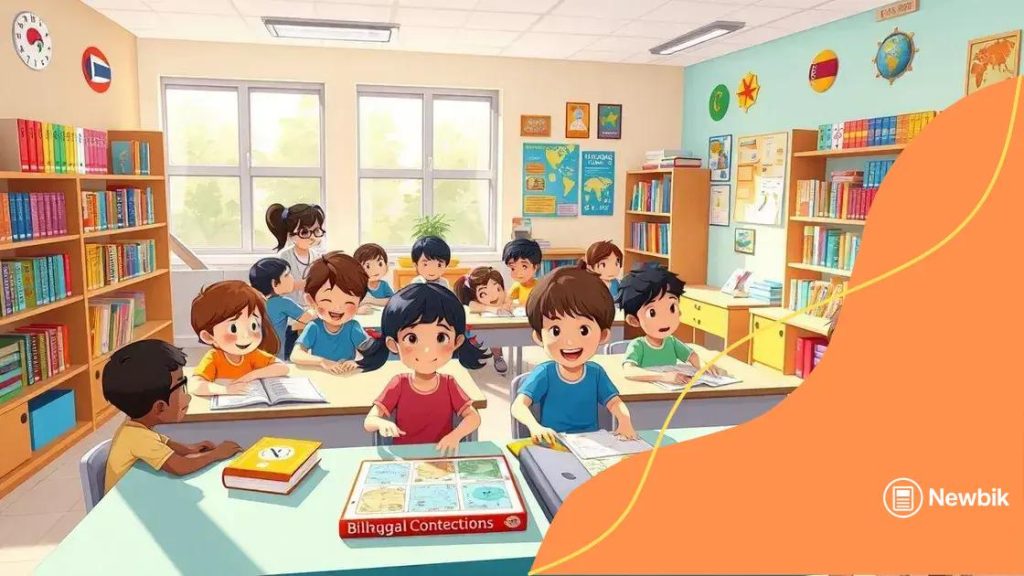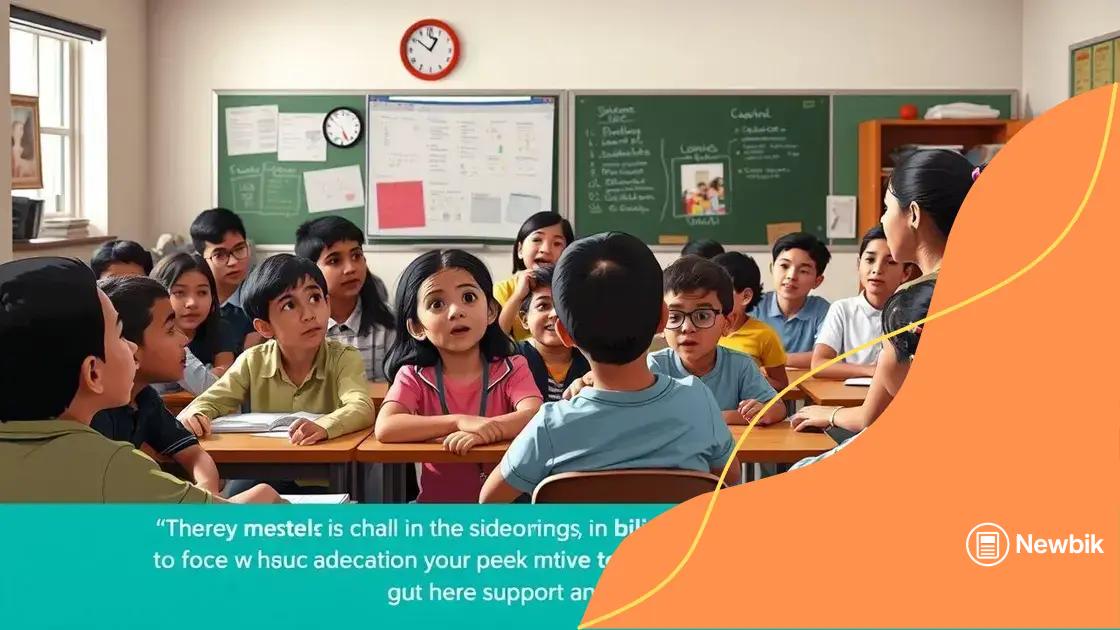Bilingual education programs growth: a rising trend

Bilingual education programs enhance cognitive skills, academic performance, and cultural awareness while facing challenges such as funding and the need for qualified teachers, and future trends include increased technology integration and advocacy for their implementation.
Bilingual education programs growth is changing the way students learn today. Schools across the globe are recognizing the value of teaching in multiple languages, sparking curiosity about how this trend impacts education. Are you ready to dive deeper into this fascinating topic?
What are bilingual education programs?
Bilingual education programs are designed to teach students in two languages. These programs aim to develop proficiency in both languages while ensuring students understand core subjects. Learning in this way can help students connect better with diverse cultures.
Types of Bilingual Education Programs
There are various types of bilingual education programs, each catering to different needs:
- Transitional programs: Help non-English speakers learn English while gradually moving to all-English instruction.
- Maintenance programs: Focus on maintaining the student’s native language while introducing a second language.
- Dual-language immersion: Teaching students in both languages to promote fluency in each.
These programs not only support language acquisition but also enhance cognitive skills. By learning in two languages, students can experience improved problem-solving abilities and creativity. Research shows that bilingual individuals often outperform their monolingual peers in various academic tasks.
Why Choose Bilingual Education?
Bilingual education presents numerous advantages. For instance, it allows children to bond with their heritage and native language while also embracing a new culture. Furthermore, bilingualism opens doors to greater career opportunities in our globalized world.
Parents often see bilingual education as beneficial, recognizing its impact on their child’s future. In addition to academic success, students gain confidence and communication skills that are vital in today’s diverse societies.
Benefits of bilingual education for students
Students who participate in bilingual education programs experience numerous benefits. These advantages extend beyond just language acquisition. When children learn in two languages, they develop enhanced cognitive skills that aid their overall academic performance.
Academic Advantages
Bilingual students often excel in subjects like math and reading.
- Improved problem-solving skills: Learning in two languages fosters critical thinking.
- Higher test scores: Bilingual students typically score better on standardized tests.
- Greater retention: Learning concepts in two languages helps students remember information longer.
Studies show that bilingual education can lead to increased creativity as students learn to think in multiple ways. They approach problems with unique perspectives, which is beneficial in both education and later in their careers.
Social and Cultural Benefits
Beyond academics, bilingual education enhances social skills. Students learn to communicate with diverse groups, promoting empathy and understanding. This exposure to different cultures provides a rich learning experience that fosters respect for others.
Moreover, being bilingual prepares students for a global workforce. Employers value individuals who can communicate in multiple languages, making these students more competitive in their careers. Being bilingual opens doors to international opportunities and experiences.
Challenges faced by bilingual education programs

Bilingual education programs offer many benefits, but they also face several challenges that can impact their effectiveness. Understanding these challenges is essential for educators, parents, and policymakers who aim to support bilingual education.
Funding and Resources
One of the primary challenges is securing adequate funding. Many schools struggle to obtain the necessary resources to implement and maintain effective bilingual programs. Limited budgets can hinder teacher training, curriculum development, and access to bilingual materials.
- Teacher recruitment: There is often a shortage of qualified bilingual teachers, making it difficult to deliver quality instruction.
- Professional development: Existing teachers may need more training to effectively teach in a bilingual setting.
- Curriculum materials: Schools may lack access to high-quality bilingual and culturally relevant instructional materials.
Moreover, financial instability can create inconsistencies in program quality, leaving students without the support they need to succeed.
Parental Involvement
Another significant challenge is the level of parental involvement. Some parents may not fully understand the importance of bilingual education. This lack of awareness can lead to limited home support for language development.
In addition, parents who themselves are not bilingual may feel unequipped to assist their children. Effective communication between schools and families is vital for fostering a strong support system. Creating opportunities for parental engagement can help bridge this gap, encouraging more families to participate in their children’s bilingual education.
Cultural and Social Barriers
Bilingual education programs also encounter cultural and social challenges. In some communities, there may be resistance to bilingual education. Misconceptions about the value of learning in two languages can pose hurdles for students and families.
Additionally, students in bilingual programs may experience social pressure or isolation from peers who are not enrolled in similar programs. Addressing these cultural dynamics is essential to creating an inclusive environment where all students can thrive.
Successful bilingual program models
Successful bilingual program models showcase effective methods for teaching students in two languages. These programs not only enhance language skills but also promote academic and social development.
Dual Language Immersion Programs
One of the most effective models is the dual language immersion program. In these programs, students learn subjects in both their native language and a second language.
- Balanced instruction: Both languages are used equally, helping students achieve fluency.
- Cultural exchange: Students from different backgrounds learn from each other, promoting diversity and inclusion.
- Positive outcomes: Research shows that dual language immersion students often outperform peers in standardized tests.
This model encourages students to become bilingual while also developing a strong sense of cultural identity.
Two-Way Immersion Programs
Another successful model is the two-way immersion program. Here, half of the students are native English speakers and the other half are native speakers of another language.
Students collaborate in mixed-language groups, which fosters teamwork and communication skills. They also benefit from:
- Peer interaction: Students learn from one another, enhancing language acquisition.
- Equal focus: Both language groups receive instruction that values their respective languages.
- Community building: This model helps create a community where all students feel included.
Such collaboration is crucial for building respect and understanding among different cultural backgrounds.
Maintenance Bilingual Programs
Maintenance bilingual programs aim to preserve the students’ native language while they learn a second language. This approach supports linguistic and cultural heritage.
Key benefits include:
- Language proficiency: Maintaining the native language promotes literacy and understanding.
- Family engagement: Parents often feel more connected and involved when their language is respected.
- Cognitive benefits: Students develop strong critical thinking skills by learning in multiple languages.
Each of these models illustrates the versatility and effectiveness of bilingual education in today’s diverse classrooms.
Future trends in bilingual education
The future of bilingual education is promising as schools increasingly recognize its importance. With globalization and diverse classrooms, the demand for bilingual programs is likely to grow.
Technology Integration
One key trend is the integration of technology into bilingual education. Tools like language learning apps and interactive software can enhance language acquisition.
- Online resources: Students will have access to a wider range of materials in both languages, making learning more engaging.
- Virtual classrooms: Technology allows for innovative teaching methods, enabling collaboration with students worldwide.
- Personalized learning: Adaptive learning platforms tailor lessons to individual student needs, fostering better outcomes.
As technology advances, educators can utilize these tools to improve bilingual instruction significantly.
Cultural Competence Emphasis
Another trend is a stronger emphasis on cultural competence within bilingual programs. Understanding and appreciating cultural differences enhance the learning environment.
Here, teachers focus on integrating cultural lessons into the curriculum. This approach benefits students by:
- Promoting respect: Students learn to appreciate diverse backgrounds.
- Fostering empathy: Cultural education encourages compassion and understanding among peers.
- Enhancing communication: Cultural awareness improves interactions in a multilingual setting.
This trend supports not only language development but also social and emotional skills.
Increased Advocacy for Bilingual Education
In recent years, advocacy for bilingual education has gained momentum. As communities push for better educational policies, schools are more likely to adopt bilingual programs.
Advocacy efforts often focus on:
- Policy changes: Encouraging lawmakers to support bilingual education funding.
- Community awareness: Educating families about the benefits of bilingualism.
- Parent engagement: Building partnerships with parents to support bilingual education initiatives.
As awareness increases, we can expect more support for enhancing bilingual programs, ensuring their success in schools.
FAQ – Frequently Asked Questions about Bilingual Education Programs
What are the main benefits of bilingual education programs?
Bilingual education programs enhance cognitive skills, improve academic performance, and promote cultural awareness among students.
What challenges do bilingual education programs face?
Some challenges include funding issues, a shortage of qualified teachers, and resistance from parents or communities regarding the value of bilingualism.
How does technology improve bilingual education?
Technology provides access to diverse learning materials and tools, supports personalized learning, and facilitates communication between students and teachers.
What future trends can we expect in bilingual education?
Future trends include increased technology integration, a focus on cultural competence, greater advocacy for bilingual programs, and an emphasis on developing global skills.